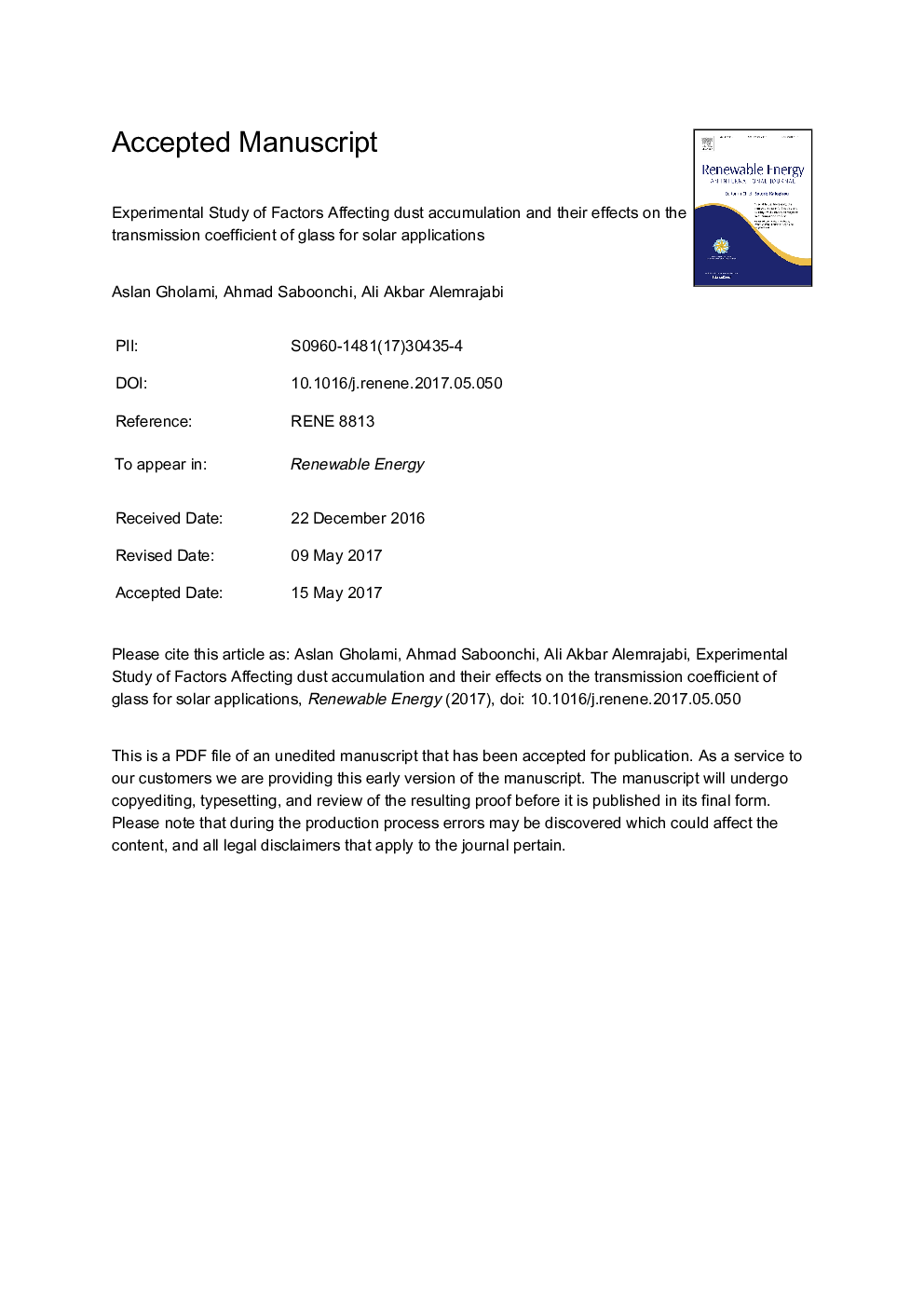| کد مقاله | کد نشریه | سال انتشار | مقاله انگلیسی | نسخه تمام متن |
|---|---|---|---|---|
| 4926145 | 1431592 | 2017 | 15 صفحه PDF | دانلود رایگان |
عنوان انگلیسی مقاله ISI
Experimental study of factors affecting dust accumulation and their effects on the transmission coefficient of glass for solar applications
ترجمه فارسی عنوان
بررسی تجربی عوامل موثر بر تجمع غبار و اثرات آن بر ضریب انتقال شیشه برای کاربردهای خورشیدی
دانلود مقاله + سفارش ترجمه
دانلود مقاله ISI انگلیسی
رایگان برای ایرانیان
کلمات کلیدی
انرژی خورشیدی، سیستم فتوولتائیک، تجمع گرد و غبار، ضریب انتقال،
ترجمه چکیده
مجموعه های خورشیدی و پانل های فتوولتائیک شایع ترین کاربردهای انرژی خورشیدی هستند. اگر چه چگونگی افزایش بهره وری این سیستم ها به روش های مختلف مورد بررسی و تحلیل قرار گرفته است، تاثیر انباشت گرد و غبار بر کارایی پانل و کلکتور تا حد زیادی نادیده گرفته شده است. برای غلبه بر این کسری، یک آزمایش در اصفهان، ایران برای بررسی عوامل موثر بر انباشت گرد و غبار و اثرات آن بر ضریب انتقال شیشه صورت گرفت. نتایج نشان می دهد عوامل مانند شیب نصب، زاویه زاویه، جهت باد غالب و زمان که نمونه ها در محیط قرار می گیرند، مربوط به تراکم تجمع گرد و غبار در کاهش ضریب انتقال و انتقال می باشد. در طی دوره آزمایشی 70 روز تا 25٪ کاهش ضریب انتقال ناشی از انباشت گرد و غبار روی سطح مشاهده شد. با توجه به اینکه تراکم پوسیدگی گرد و غبار به شدت وابسته به شرایط آب و هوایی در طول دوره آزمون است، بر خلاف مطالعات قبلی، در این مقاله نسبت انتقال کاهش به جای زمان، از نظر تراکم تجمع غبار بر روی سطح مشتق شده است. این معادله تعمیم یافته و قابل اجرا به مناطق دیگر و حتی شرایط مختلف آب و هوایی است.
موضوعات مرتبط
مهندسی و علوم پایه
مهندسی انرژی
انرژی های تجدید پذیر، توسعه پایدار و محیط زیست
چکیده انگلیسی
Solar collectors and Photovoltaic panels are the most common applications of solar energy. Although how to increase the efficiency of these systems in different ways has been vastly studied and analyzed, the effect of dust accumulation on panel's and collector's efficiency has been largely ignored. To overcome this deficit, an experiment was developed in Isfahan, Iran, to investigate the factors affecting dust accumulation and their effects on the transmission coefficient of glass. The results indicate factors such as installation tilt, azimuth angle, dominant wind direction and the time in which samples are placed within the environment, are related to dust accumulation density on surface and transmission coefficient reduction. Up to 25% decline in the transmission coefficient caused by the accumulation of dust on the surface was observed during the 70-day test period. Given that the dust fall density is strictly depended on weather conditions during the test period, unlike previous studies, in this article the transmission reduction relation, instead of time is derived in terms of dust accumulation density on the surface. This equation is generalized and applicable to other regions and even different weather conditions.
ناشر
Database: Elsevier - ScienceDirect (ساینس دایرکت)
Journal: Renewable Energy - Volume 112, November 2017, Pages 466-473
Journal: Renewable Energy - Volume 112, November 2017, Pages 466-473
نویسندگان
Aslan (Master of Mechanical Engineering), Ahmad (Professor), Ali Akbar (Professor),
